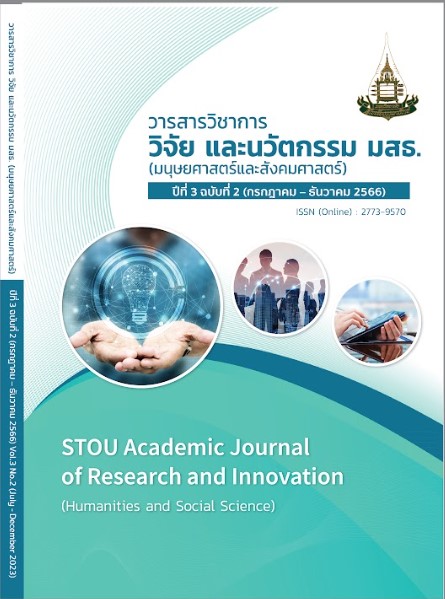แนวทางการเพิ่มประสิทธิภาพการสื่อสารในองค์กร กรณีศึกษาธนาคารออมสิน
Keywords:
Communication, Internal Communication, Efficiency of Internal Communication of organizationAbstract
The research aimed to examine the connection between organizational communication and the performance of Government Savings Bank personnel. The goal was to establish guidelines for improving the communication system within the organization, with the aim of enhancing the operational efficiency of the personnel. The research followed a quantitative approach, using a questionnaire to collect data from a sample group of 400 Government Savings Bank personnel. Data analysis involved statistical methods such as percentage, mean, standard deviation, t-test, F test (one-way ANOVA), and correlation coefficient. The findings of the research revealed the following points: 1) The majority of the sample group consisted of female personnel aged 20-30 years, holding a bachelor's degree, and working in operator positions. 2) The study found that the communication system within the organization had a significant impact on the work efficiency of the Government Savings Bank personnel. All five aspects of communication examined in the research were found to be related to communication efficiency within the organization. Enhancing communication effectiveness was found to be most dependent on the sender's communication skills. Other factors such as communication channels, feedback mechanisms, information dissemination, and the sender's attributes also played significant roles. To improve communication skills among recipients, the research suggests conducting training sessions to enhance their abilities and knowledge in efficient communication techniques and coordination. This strategy aims to foster good working relationships, create mutual understanding, and enable the organization to achieve its goals. The research emphasizes the importance of practicing effective speaking skills, including the use of appropriate verbal and non-verbal language. It also highlights the significance of effective listening skills, which involve stages such as pre-listening, listening, and post-listening, along with practicing proper etiquette. Additionally, the research recommends developing reading skills through activities such as preparing before reading, thinking, analyzing, and taking notes. Finally, it suggests practicing writing skills, including identifying topics, reviewing literature, outlining, writing, and proofreading.
References
บัณฑิกา จารุมา และพยอม ก้อนในเมือง. (2563). วิธีพัฒนาทักษะการสื่อสารที่มีประสิทธิภาพ. วารสาร มจร มนุษยศาสตร์ปริทรรศน์, 6(1), 413-428.
ณัฏฐ์ชุดา วิจิตรจามรี. (2561). การสื่อสารในองค์การ. (พิมพ์ครั้งที่ 4). กรุงเทพฯ: สำนักพิมพ์มหาวิทยาลัย เกษตรศาสตร์.
ธนาคารออมสิน. (2563). ประวัติของธนาคารออมสิน. จาก https://www.gsb.or.th/
นิติพล ภูตะโชติ. (2562). พฤติกรรมองค์กร. (พิมพ์ครั้งที่ 5). กรุงเทพฯ: จุฬาลงกรณ์มหาวิทยาลัย.
ภาวิณี เพชรสว่าง. (2564). กลยุทธ์การวางแผนทรัพยากรมนุษย์. กรุงเทพฯ: จุฬาลงกรณ์มหาวิทยาลัย.
สมคิด บางโม. (2562). องค์การและการจัดการ. กรุงเทพฯ: ซีเอ็ดยูเคชั่น.
สัญชาติ พรมดง, นันทนา นิจจอหอ และนาถรพี ชัยมงคล. (2561). การสร้างประสิทธิภาพของการสื่อสารในองค์กร เพื่อเพิ่มความสามารถในการแข่งขันทางธุรกิจ. วารสารเครือข่ายส่งเสริมการวิจัยทางมนุษยศาสตร์และสังคมศาตร์, 1(1), 50-59.
Yamane, T. (1973). Statistics: An Introductory Analysis. (3rd ed.). New York: Harper and Row Publications.
Razmerita, L., Kirchner, K., & Nielsen, P. (2016). What factors influence knowledge sharing in organizations? A social dilemma perspective of social media communication. Journal of knowledge Management, 20(6), 1225-1246.
Downloads
Published
How to Cite
Issue
Section
License
Copyright (c) 2023 STOU Academic Journal of Research and Innovation (Humanities and Social Science) (Online)

This work is licensed under a Creative Commons Attribution-NonCommercial-NoDerivatives 4.0 International License.





